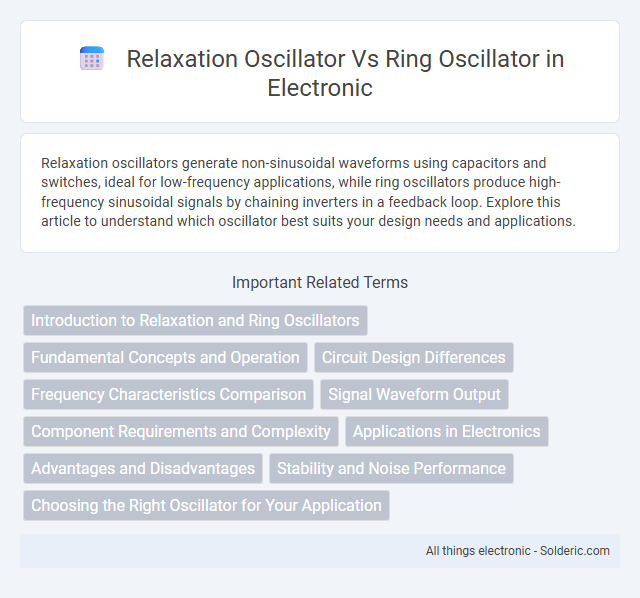Relaxation oscillators generate non-sinusoidal waveforms using capacitors and switches, ideal for low-frequency applications, while ring oscillators produce high-frequency sinusoidal signals by chaining inverters in a feedback loop. Explore this article to understand which oscillator best suits your design needs and applications.
Comparison Table
| Feature | Relaxation Oscillator | Ring Oscillator |
|---|---|---|
| Oscillation Principle | Charging and discharging of capacitor through resistor | Propagation delay through odd number of inverter stages |
| Frequency Range | Low to moderate frequencies | High frequencies, depends on inverter delay |
| Waveform Output | Non-sinusoidal (triangular, sawtooth) | Square wave |
| Complexity | Simple design, fewer components | Requires multiple inverter stages |
| Power Consumption | Lower power | Higher power due to multiple active stages |
| Tuning | Easy frequency adjustment via RC values | Frequency adjustment by varying inverter count or supply voltage |
| Applications | Timers, pulse generation, LED blinkers | Clock generation, delay lines, on-chip oscillators |
Introduction to Relaxation and Ring Oscillators
Relaxation oscillators generate periodic waveforms by charging and discharging a capacitor through a resistor, producing non-sinusoidal signals typically used in timing circuits. Ring oscillators consist of an odd number of inverters connected in a ring, creating oscillations based on the propagation delay through each stage, resulting in high-frequency signals commonly applied in integrated circuit testing. Both oscillator types differ fundamentally in their mechanisms and output waveforms, influencing their selection for specific electronic applications.
Fundamental Concepts and Operation
Relaxation oscillators generate a non-sinusoidal periodic output by charging and discharging a capacitor through a resistor, relying on threshold detection to switch states, making them suitable for low-frequency applications. Ring oscillators consist of an odd number of inverters connected in a loop, producing a continuous sequence of digital pulses with frequency determined by the propagation delay of each inverter stage. The fundamental difference lies in their operation: relaxation oscillators depend on RC timing components and threshold switching, while ring oscillators depend on digital gate delays to create oscillations.
Circuit Design Differences
A relaxation oscillator uses a capacitor that charges and discharges through a resistor to generate a non-sinusoidal waveform, relying on components such as unijunction transistors or operational amplifiers. In contrast, a ring oscillator consists of an odd number of inverters connected in a loop, producing a periodic output without external timing components by relying purely on gate delays. Your choice depends on circuit complexity and frequency stability requirements, as relaxation oscillators are simpler but less stable than the inherently high-frequency ring oscillators.
Frequency Characteristics Comparison
Relaxation oscillators typically generate low-frequency signals with less precision, as their frequency depends on the charging and discharging of a capacitor. Ring oscillators produce higher frequencies due to the propagation delay through an odd number of inverters connected in a loop, allowing finer frequency tuning with technology scaling. Frequency stability in ring oscillators is superior, benefiting from faster switching speeds, while relaxation oscillators excel in simplicity and are less sensitive to process variations.
Signal Waveform Output
Relaxation oscillators produce non-sinusoidal waveforms such as sawtooth or square waves characterized by rapid voltage transitions and slower linear charge or discharge phases. Ring oscillators generate nearly sinusoidal or triangular waveforms resulting from the propagation delay through a loop of inverters, producing periodic pulses with fast rise and fall times. Your choice between the two depends on the desired waveform shape and timing precision needed for your specific application.
Component Requirements and Complexity
Relaxation oscillators require fewer components, typically involving a resistor, capacitor, and a switching device, making them simpler and more cost-effective for low-frequency applications. Ring oscillators consist of an odd number of inverters connected in a loop, increasing component count and complexity, but enabling higher frequency oscillation and easier integration in digital circuits. The choice between these oscillators depends on design constraints related to component availability, required frequency range, and circuit complexity tolerance.
Applications in Electronics
Relaxation oscillators are widely used in low-frequency signal generation, such as in timing circuits, alarms, and pulse generators due to their simplicity and ability to produce non-sinusoidal waveforms like square and sawtooth waves. Ring oscillators excel in high-speed digital circuits, particularly for on-chip clock generation, frequency synthesis, and delay measurement, benefiting from their compact design and frequency tunability through inverter stages. Both oscillator types play critical roles in integrated circuits, with relaxation oscillators favored for stable, low-frequency timing functions and ring oscillators optimized for high-frequency clocking and performance testing in VLSI designs.
Advantages and Disadvantages
Relaxation oscillators offer simplicity and low-frequency operation with ease of implementation using fewer components, but they suffer from limited frequency stability and lower precision compared to ring oscillators. Ring oscillators provide high-frequency oscillation with better integration in CMOS technology and precise frequency control through the number of stages, though they consume more power and generate noise due to continuous switching. Choosing between them depends on the application requirements for frequency range, stability, power consumption, and implementation complexity.
Stability and Noise Performance
Relaxation oscillators typically exhibit lower frequency stability and higher phase noise due to their abrupt switching behavior and reliance on RC time constants. Ring oscillators offer better frequency stability with smoother waveform transitions but are more susceptible to noise from supply voltage variations and device mismatch. Your choice depends on whether consistent frequency or minimal phase noise is more critical for your application.
Choosing the Right Oscillator for Your Application
Relaxation oscillators are ideal for applications requiring low-frequency signals, simple circuitry, and precise timing due to their easy implementation and stable output. Ring oscillators, on the other hand, generate high-frequency signals through a loop of inverters, making them suitable for integrated circuits and high-speed timing tasks. Your choice depends on the frequency range, power consumption, and integration needs specific to your project's requirements.
Relaxation oscillator vs Ring oscillator Infographic

 solderic.com
solderic.com